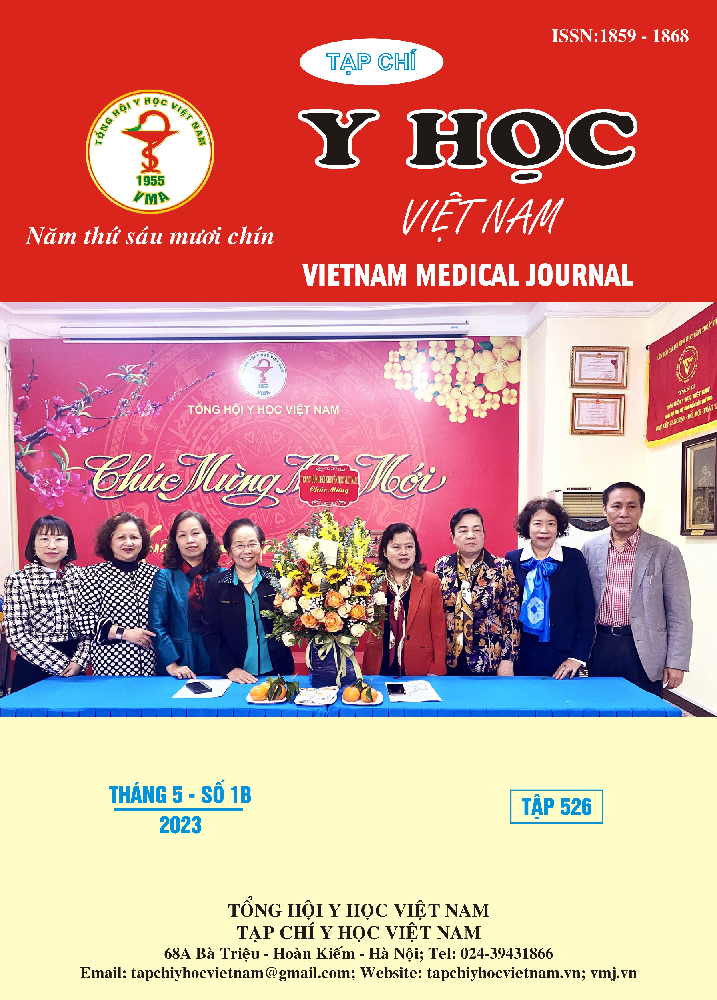THE ASSOCIATION BETWEEN SEVERAL HYPERCOAGULATION RISK FACTORS AND MAGNETIC RESONANCE IMAGING OF CEREBRAL VENOUS THROMBOSIS
Main Article Content
Abstract
Objective: To analysis the relationship between hypercoagulation risk factors and magnetic resonance imaging of cerebral venous thrombosis. Subjects and methods: A prospective, descriptive study of 38 patients with cerebral venous thrombosis treated at the Neurology Center, Bach Mai Hospital from March 2020 to June 2021. Results: The mean age was 42.4 ± 14.8, the male/female ratio was 1.2:1. The rate of anticoagulant proteins (PC, PS, ATIII) deficiency associated with primary hypercoagulability was 39.5%, of which protein S deficiency was the most common (21.1%), followed by protein C and ATIII deficiency (18,4% and 10.5%, respectively). The risk factors of secondary hypercoagulation related to antibodies were found with a low rate, of which antiphospholipid antibodies percentage was the highest (5.3%), other antibodies with lower proportion were antinuclear antibodies ANA (2.6%), anti-dsDNA antibodies (2.6%), anti-cardiolipin antibodies (2.6%). There was no association between hypercoagulation risk factors with brain parenchymal damage and the site of thrombosis. Conclusions: The rate of anticoagulant proteins (PC, PS, ATIII) deficiency associated with primary hypercoagulability was 39.5%, of which protein S deficiency was the most common (21.1%). The risk factors for secondary hypercoagulation related to antibodies were found with a low rate. There was no association between hypercoagulation risk factors with brain parenchymal damage and the site of thrombosis.
Article Details
Keywords
Cerebral venous thrombosis, risk factors, magnetic resonance imaging
References
2. P. C, Ferro J. M., Lindgren A. G., et al. Causes and Predictors of Death in Cerebral Venous Thrombosis. Stroke. 2005;36:1720-1725.
3. Coutinho JM, Ferro JM, Canhao P, et al. Cerebral venous and sinus thrombosis in women. Stroke. 2009;40(7):2356-2361.
4. Caso V, Agnelli G, Paciaroni M. Handbook on cerebral venous thrombosis. Karger Medical and Scientific Publishers; 2008:16-22.
5. Lê Văn Thính, Nhận xét một số đặc điểm lâm sàng, cận lâm sàng và điều trị huyết khối tĩnh mạch não. Tập san Hội Thần kinh học Việt Nam, 2, 10. 2010;
6. Trịnh Tiến Lực, Nghiên cứu đặc điểm lâm sàng và hình ảnh học của bệnh nhân huyết khối tĩnh mạch não Luận án Tiến sỹ y học, Đại học Y Hà Nội. 2020;
7. Zubkov AY, McBane RD, Brown RD, Rabinstein AA. Brain lesions in cerebral venous sinus thrombosis. Stroke. 2009;40(4):1509-1511.


